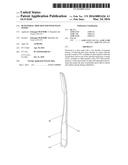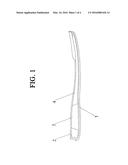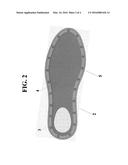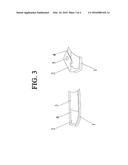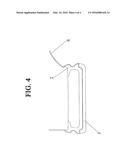Patent application title: BI-MATERIAL SHOE BOTTOM WITH FOAM INSERT
Inventors:
Giuseppe Olivieri (Benedetto Del Tronto (ap), IT)
IPC8 Class: AA43B1312FI
USPC Class:
36 28
Class name: Boots, shoes, and leggings soles cushion
Publication date: 2016-03-24
Patent application number: 20160081426
Abstract:
Disclosed is a shoe made with a soft, flexible, bi-material bottom, of
which the first layer, directly in contact with the ground, is made of
TPU, or leather or other material, while the second layer, laid on top of
the said first tread layer, is made of PU, or leather or other material,
with a PVC film and has inside it a foam insert made of open-cell
expanded polyurethane that makes the shoe comfortable and is able to
absorb and cushion shocks during ambulation.Claims:
1. Bi-material shoe bottom comprising a first tread layer made of TPU or
leather or other material, a second layer made of PU or leather or other
material laid on top of the said first layer and a PVC film placed
between the first tread layer and the second layer, characterized in that
the second layer has inside it an insert made of open-cell expanded
polyurethane that has a higher density in the heel area than in the sole
and plantar arch area.
2. Bi-material bottom according to claim 1 characterized in that the said open-cell expanded polyurethane has a density ranging from 50 kg/m3 to 75 kg/m3 in the sole and plantar arch area and from 95 kg/m3 to 120 kg/m3 in the heel area.
3. Bi-material shoe bottom comprising a first tread layer made of TPU or leather or other material, a second layer made of PU or leather or other material laid on top of the said first layer and a PVC film placed between the first tread layer and the second layer characterized in that, the second layer has inside it an insert made of open-cell expanded polyurethane having a single density for both the heel area and the sole and plantar arch area.
4. Bi-material bottom according to claim 1 characterized in that the second PU layer has holes made on its outer edge that form a locking system for the said open-cell expanded polyurethane.
5. Bi-material bottom according to claim 3, characterized in that the second PU layer has holes made on its outer edge that form a locking system for the said open-cell expanded polyurethane.
Description:
CROSS-REFERENCE TO RELATED U.S. APPLICATIONS
[0001] Not applicable.
STATEMENT REGARDING FEDERALLY SPONSORED RESEARCH OR DEVELOPMENT
[0002] Not applicable.
NAMES OF PARTIES TO A JOINT RESEARCH AGREEMENT
[0003] Not applicable.
REFERENCE TO AN APPENDIX SUBMITTED ON COMPACT DISC
[0004] Not applicable.
BACKGROUND OF THE INVENTION
[0005] 1. Field of the Invention
[0006] The present invention is related to the footwear sector and more specifically concerns a shoe made with a soft, flexible, bi-material bottom, of which the first layer, directly in contact with the ground, is made of TPU, or leather or other material, while the second layer, laid on top of the said first tread layer, is made of PU, or leather or other material, with a PVC film and has inside it a foam insert made of open-cell expanded polyurethane that makes the shoe comfortable and is able to absorb and cushion shocks during ambulation.
[0007] 2. Description of Related Art Including Information Disclosed Under 37 CFR 1.97 and 37 CFR 1.98.
[0008] In the current art, in the cushioned and comfortable shoe sector, for those who have to stand or walk for a long time, with consequent pain and swelling of the feet and ankles, tiredness or inflammation of the feet and ankles, there exist various types of shoes that use breathable materials and have arch supports that are able to reduce the feeling of fatigue. Moreover, for those suffering from particular pathologies such as inflamed heel, plantar fasciitis, calcaneal spur, flat foot, hallux valgus and other disorders, shoe soles exist on the market that have areas suitable for including a raised cushioning part at the various foot support points, such as the heel for example. If placed at the heel, the said raised parts are called "heel socks" and, if inserted inside the shoe, they are able to absorb the impacts of the sole of the foot with the ground from running or just walking; moreover, they rebalance the posture and correctly modify ambulation.
[0009] In the current art, there also exist shoes having insoles that, when inserted inside any type of shoe and placed in contact with the foot, enable it to be massaged during normal ambulation with the consequence of improving the wearer's comfort.
[0010] In the said field of cushioned and comfortable shoes as described above, there also exist shoes that include a sole consisting of closed-cell polyurethane foam castings; the said soles thus formed do not however allow good circulation of air inside the shoe, since they do not achieve high breathability, besides not being very soft.
BRIEF SUMMARY OF THE INVENTION
[0011] It is an object of the present invention to fit a shoe with a bottom made of PU/TPU or leather or other material with an open-cell expanded polyurethane insert that is anallergic, antibacterial, anti-mould, anti-shock and contained inside one of the two materials.
[0012] It is another object of the present invention to fit a shoe with a bottom made of PU/TPU or leather or other material whose open-cell expanded polyurethane insert contained inside one of the two materials has up to now commonly been used for other purposes such as stuffing mattresses, divans and such like.
[0013] It is another object of the present invention to fit a shoe with an insert contained inside the bottom, applied by casting or pre-formed, that has a higher density in the heel area and lower density in the sole and plantar arch area, so as to promote and improve venous return in blood circulation.
[0014] Another object of the present invention is fit a shoe with a bottom that is able to promote excellent air circulation between the bottom and the internal insole of the shoe when the foot presses on the ground, thus eliminating the problem of foot perspiration.
[0015] Another object of the present invention is to fit a shoe with a bottom with an open-cell expanded polyurethane insert whose anti-shock properties allow the said shoe to be used optimally even by the diabetic foot.
[0016] It is a further object of the present invention to fit a shoe with a bottom with an open-cell expanded polyurethane insert whose anti-shock properties are also able to improve the antigravitational response to stresses to reduce the load on the spine.
[0017] It is still another object of the present invention to fit a shoe with an open-cell expanded polyurethane bottom whose costs for the insert having anallergic, antibacterial, anti-mould and anti-shock properties are decidedly lower than those for inserts used up to now in the field of comfortable shoes.
[0018] These and other objects are achieved with the present invention that concerns a bi-material shoe bottom whose first layer, which is directly in contact with the ground, is made of TPU, or leather or other material, while the second layer, laid on top of the said first tread layer, is made of PU, or leather or other material, with a PVC film and has inside it an insert made with open-cell polyurethane foam that, through a known chemical reaction following the casting of it, forms open-cell expanded polyurethane commonly called foam rubber since the result of the said known reaction is a spongy material.
BRIEF DESCRIPTION OF THE DRAWINGS
[0019] Further features and advantages of the invention will be more readily apparent from the description of a preferred, but not exclusive, embodiment of the product that is the subject of the present patent application, illustrated by way of non-limiting example in the drawing units in which:
[0020] FIG. 1 shows a cutaway side view of a shoe made with a bi-material bottom in which the first layer (1), which is directly in contact with the ground, is made of TPU, while the second layer (2), laid on top of the said first tread layer (1), is made of PU with a PVC film (6) (as shown in FIG. 4) and has inside it a foam insert made of open-cell expanded polyurethane with a higher density in the heel area (3) than in the sole and plantar arch area (4).
[0021] FIG. 2 shows a top view of a shoe in which the second PU layer (2) of the bi-material bottom is made in such a way as to have, on its outer edge, equally spaced holes (5) that form the locking system for the open-cell expanded polyurethane with higher density in the heel area (3) and lower density in the sole and plantar arch area (4).
[0022] FIG. 3 shows a section view of two parts of the shoe described in terms of its components in the previous figures.
[0023] FIG. 4 shows a section view of the bi-material bottom of the shoe that highlights the PVC film (6) placed between the first TPU tread layer (1) and the second PU layer (2).
DETAILED DESCRIPTION OF THE INVENTION
[0024] The present invention concerns a foam insert made of open-cell expanded polyurethane that has a higher density in the heel area (3) than in the sole and plantar arch area (4), inserted in a bi-material shoe bottom whose first layer (1) directly in contact with the ground is made of TPU, or leather or other material, while the second layer (2), laid on top of the said first tread layer (1), is made of PU, or leather or other material, with a PVC film (6) according to a preferred--but non-limiting--embodiment.
[0025] The characteristic value of the invention is given by the softness of the open-cell expanded polyurethane insert that has a density ranging from 50 kg/m3 to 75 kg/m3 in the sole and plantar arch area (4) and from 95 kg/m3 to 120 kg/m3 in the heel area (3) to prevent the foot from sinking excessively at the heel.
[0026] The said open-cell expanded polyurethane is a very soft material, with memory effect similar to a foam rubber mattress, with very reasonable costs. The strength and firmness of the open-cell expanded polyurethane varies depending on the making requirements and according to the degree of insert softness one wants to obtain.
[0027] A further embodiment involves the use of a foam insert made of open-cell expanded polyurethane having a single density for the heel area (3) and the sole and plantar arch area (4).
[0028] The open-cell polyurethane foam can be cast into the bi-material bottom of the shoe above the PU layer (2) and penetrate into the holes (5) made on the outer edge of the said PU layer (2) so that the said holes (5) form a locking system for the said polyurethane foam that takes place when, through a known chemical reaction following the casting of it, the polyurethane foam becomes open-cell expanded polyurethane commonly called foam rubber since the result of the said known reaction is a spongy material; or the said polyurethane foam can be pre-formed and inserted according to the specific use.
[0029] The said foam is thicker in the heel area (3) and gradually becomes thinner in the sole and plantar arch area (4), so that there is the sensation of walking on a foam rubber mattress that adapts to the physiological anatomy of the foot. The use of the said foam promotes a reduction in the pressure and stresses of the body, so improving venous circulation and ensuring a pleasant physical sensation and an increase in personal comfort.
[0030] Moreover, the said foam maintains its softness even though climatic conditions vary from damp to dry and vice versa.
[0031] The said material also has the characteristic of being vibration absorbing and anallergic and has good mechanical durability (Memory Effect). Its dense structure also prevents water from penetrating so making it waterproof, but it is able to absorb moisture and allow moisture to breathe out so as to keep the parts in contact with it at an ideal body temperature.
[0032] According to the preferred--but non-limiting--embodiment of the above-presented invention, on top of the said foam insert, to ensure that the foot does not come directly into contact with it, there is a biodegradable lasting insole that is perforated along its entire length, so as to allow air circulation inside the shoe. Thanks to the pressure that occurs during ambulation, there is the effect of removing foot perspiration.
[0033] On top of the said biodegradable insole, there is an anatomical latex footbed with strategic points in the plantar and metatarsus area that, through pressure, from the sole of the foot, directly affect various parts of the body, so making the support suitable for the physiology of the foot in both a static and dynamic position.
[0034] The materials and dimensions of the insert invention made of open-cell expanded polyurethane as described above, illustrated in the accompanying drawings and later claimed, can be of any kind according to requirements. Moreover, all the details can be replaced with other technically equivalent ones without for this reason straying from the protective scope of the present patent application.
User Contributions:
Comment about this patent or add new information about this topic:

